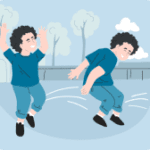The Importance of Diagnosing Sensory Processing Disorders (SPD)
Sensory Processing Disorder (SPD) is a condition that affects how the brain processes sensory information, leading to challenges in everyday tasks and interactions. Early identification and diagnosis of SPD can significantly improve a child’s quality of life and development. This blog aims to shed light on the importance of diagnosing SPD, highlighting its impact on learning, behavior, and social interactions, and emphasizing the crucial roles parents, educators, and therapists play in addressing this condition.
Early Diagnosis: Unlocking Potential and Enhancing Quality of Life
Early diagnosis of SPD is pivotal. When identified at an early stage, appropriate interventions can be implemented, which greatly enhances a child’s ability to manage their sensory needs. This proactive approach can lead to:
- Improved Academic Performance: Children with SPD often struggle in traditional classroom settings. Early diagnosis can lead to tailored educational strategies that accommodate their unique needs.
- Enhanced Social Skills: Early intervention programs can help children develop better coping mechanisms, enabling them to interact more effectively with peers and adults.
- Better Behavioral Outcomes: Recognizing and addressing SPD early can reduce frustration and behavioral issues, as children learn how to process sensory inputs more effectively.

The Impact of SPD on Learning, Behavior, and Social Interactions
Children with SPD can experience profound difficulties in various aspects of their lives, including:
- Learning: Sensory overload or under-responsiveness can make it hard for children to focus, follow instructions, and engage in classroom activities.
- Behavior: Inability to process sensory information correctly can result in emotional outbursts, withdrawal, or seemingly irrational behaviors.
- Social Interactions: Difficulty in interpreting sensory cues can hinder social interactions, leading to isolation and difficulty in making friends.
Recognizing and Addressing SPD: The Role of Parents and Educators
Parents and educators are often the first to notice signs of SPD. Awareness and vigilance are key to early detection. Common signs to look out for include:
- Over-sensitivity: Fear of loud noises, dislike of being touched, and difficulty with certain textures.
- Under-sensitivity: High pain tolerance, constant need for movement, and seeking intense sensory experiences.
- Motor Skills Challenges: Difficulty with fine and gross motor skills, such as holding a pencil or participating in sports.
Parents and educators should collaborate to create a supportive environment that caters to the child’s sensory needs. This includes:
- Creating a Sensory-Friendly Environment: Adjusting lighting, reducing noise, and providing sensory breaks during the day.
- Individualized Support Plans: Developing and implementing tailored educational and behavioral strategies in collaboration with therapists.

The Crucial Role of Occupational and Physical Therapists
Occupational and physical therapists play a vital role in the diagnosis and treatment of SPD. They utilize various strategies to help children manage their sensory processing challenges, including:
- Sensory Integration Therapy: Activities designed to help children respond more appropriately to sensory stimuli.
- Motor Skill Development: Exercises to improve coordination, balance, and fine motor skills.
- Education and Training: Providing parents and educators with strategies to support the child’s sensory needs at home and in school.
The Benefits of Early Intervention
Early intervention is essential for children with SPD, offering numerous benefits such as:
- Improved Sensory Processing: Early therapeutic interventions help children develop better sensory processing skills, leading to improved daily functioning.
- Enhanced Emotional Regulation: Teaching children coping mechanisms early on helps them manage their emotions and reduces anxiety.
- Better Long-Term Outcomes: Early diagnosis and intervention can lead to more positive long-term outcomes in academics, social skills, and overall well-being.
Subtypes of Sensory Processing Disorders
Sensory Processing Disorder encompasses a variety of subtypes that reflect the diverse ways in which sensory information can be misinterpreted by the brain. Understanding these subtypes is crucial for tailoring effective interventions and support strategies. The primary subtypes of SPD include:
- Sensory Modulation Disorder (SMD): This subtype involves difficulty regulating responses to sensory input.
- Sensory Over-Responsivity (SOR): Children overreact to sensory input that most people find tolerable, resulting in avoidance behaviors and heightened sensitivity.
- Sensory Under-Responsivity (SUR): Children underreact to sensory inputs, appearing lethargic or uninterested, and may require more intense sensory experiences to engage.
- Sensory Seeking/Craving (SS): Children display an insatiable desire for sensory experiences, often engaging in risky or disruptive behaviors to fulfill their sensory needs.
- Sensory-Based Motor Disorder (SBMD): This subtype affects the physical response to sensory information, impacting motor skills and coordination. SBMD includes:
- Dyspraxia: Challenges with planning and executing motor tasks, leading to clumsiness and difficulty with activities that require fine and gross motor skills.
- Postural Disorder: Problems with balance, muscle tone, and maintaining proper posture, which can affect a child’s ability to participate in physical activities.
- Sensory Discrimination Disorder (SDD): This subtype involves difficulties in distinguishing between different types of sensory input, making it hard to categorize and process sensory information accurately. Children with SDD may struggle with tasks such as differentiating between similar sounds, identifying objects by touch, or sensing the position of their body in space.
By recognizing and diagnosing these subtypes, parents, educators, and therapists can develop more targeted approaches that address the specific sensory processing challenges faced by each child, ultimately fostering a more supportive and effective environment for their growth and development.
Conclusion
Diagnosing Sensory Processing Disorder early can make a world of difference in a child’s life. It is essential for parents, educators, and therapists to work together to recognize the signs of SPD and implement early interventions. By doing so, we can ensure that children with SPD receive the support they need to thrive in all areas of their lives.
For more information and resources on Sensory Processing Disorder and other disorders, please visit www.DrSensory.com. If you are a specialist in sensory processing disorders, ADHD, or autism spectrum disorder, please contact us to be added to our Specialist Database. Together, we can create a more inclusive and supportive environment for children with sensory processing challenges.












 Speech Therapy
Speech Therapy Physical Therapy
Physical Therapy Occupational Therapy
Occupational Therapy

